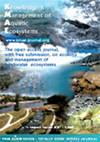The diversity of annelids in subterranean waters: a case study from Poland
IF 1.7
3区 环境科学与生态学
Q3 FISHERIES
引用次数: 1
Abstract
Not all invertebrate groups commonly occur in subterranean waters but annelids live in surface and underground habitats. The annelid species' richness in various underground waters (wells and interstitial and cave waters) and surface streams of Poland was compared, and the habitat preferences for the most frequent species were determined. Until now, 111 annelid taxa (mainly oligochaetes) had been identified in underground waters in Poland, with higher numbers (71) in the interstitial habitat than in stream bottoms (62). The number of species identified in the caves and wells was distinctly lower (54 and 29, respectively). The Correspondence Analysis did not separate the samples from various underground water types into distinct groups, and the distribution of well fauna was especially scattered (in the ordination diagram) because abiotic parameters differ strongly in studied wells. Only three stygobiontic species (Cernosvitoviella parviseta,Enchytraeus dominicaeandTrichodrilus moravicus) were related to some caves. The analysis of the available data indicate that to obtain a comprehensive picture of the aquatic fauna in a given country all types of subterranean aquatic habitats should be sampled and taken into account. Moreover, to ascertain the composition of benthic invertebrates in running waters, investigation of the interstitial habitat should also be performed.地下水中环节动物的多样性:来自波兰的案例研究
并非所有无脊椎动物都生活在地下水中,但环节动物生活在地表和地下栖息地。比较了波兰不同地下水(井、间隙水和洞穴水)和地表溪流中环节动物物种的丰富度,确定了最常见物种的生境偏好。到目前为止,已经在波兰的地下水中发现了111个环节动物分类群(主要是寡毛纲动物),其中在间隙栖息地的数量(71个)比在溪流底部的数量(62个)要多。在洞穴和井中发现的物种数量明显较少(分别为54种和29种)。对应分析并没有将不同地下水类型的样品划分为不同的类群,而且由于所研究井的非生物参数差异较大,井动物群的分布尤其分散(在排序图中)。与部分洞穴有亲缘关系的只有3种茎生菌(Cernosvitoviella parviseta、Enchytraeus dominicae和trichodrilus moravicus)。对现有数据的分析表明,为了全面了解某一国家的水生动物群,应对所有类型的地下水生生境进行取样并加以考虑。此外,为了确定流动水体中底栖无脊椎动物的组成,还应进行间隙生境调查。
本文章由计算机程序翻译,如有差异,请以英文原文为准。
求助全文
约1分钟内获得全文
求助全文
来源期刊

Knowledge and Management of Aquatic Ecosystems
环境科学-海洋与淡水生物学
CiteScore
3.70
自引率
5.60%
发文量
22
审稿时长
>12 weeks
期刊介绍:
Knowledge and Management of Aquatic Ecosystems (KMAE-Bulletin Français de la Pêche et de la Pisciculture since 1928) serves as a foundation for scientific advice across the broad spectrum of management and conservation issues related to freshwater ecosystems.
The journal publishes articles, short communications, reviews, comments and replies that contribute to a scientific understanding of freshwater ecosystems and the impact of human activities upon these systems. Its scope includes economic, social, and public administration studies, in so far as they are directly concerned with the management of freshwater ecosystems (e.g. European Water Framework Directive, USA Clean Water Act, Canadian Water Quality Guidelines, …) and prove of general interest to freshwater specialists. Papers on insular freshwater ecosystems and on transitional waters are welcome. KMAE is not a preferred journal for taxonomical, physiological, biological, toxicological studies, unless a clear link to ecological aspects can be established. Articles with a very descriptive content can be accepted if they are part of a broader ecological context.
 求助内容:
求助内容: 应助结果提醒方式:
应助结果提醒方式:


